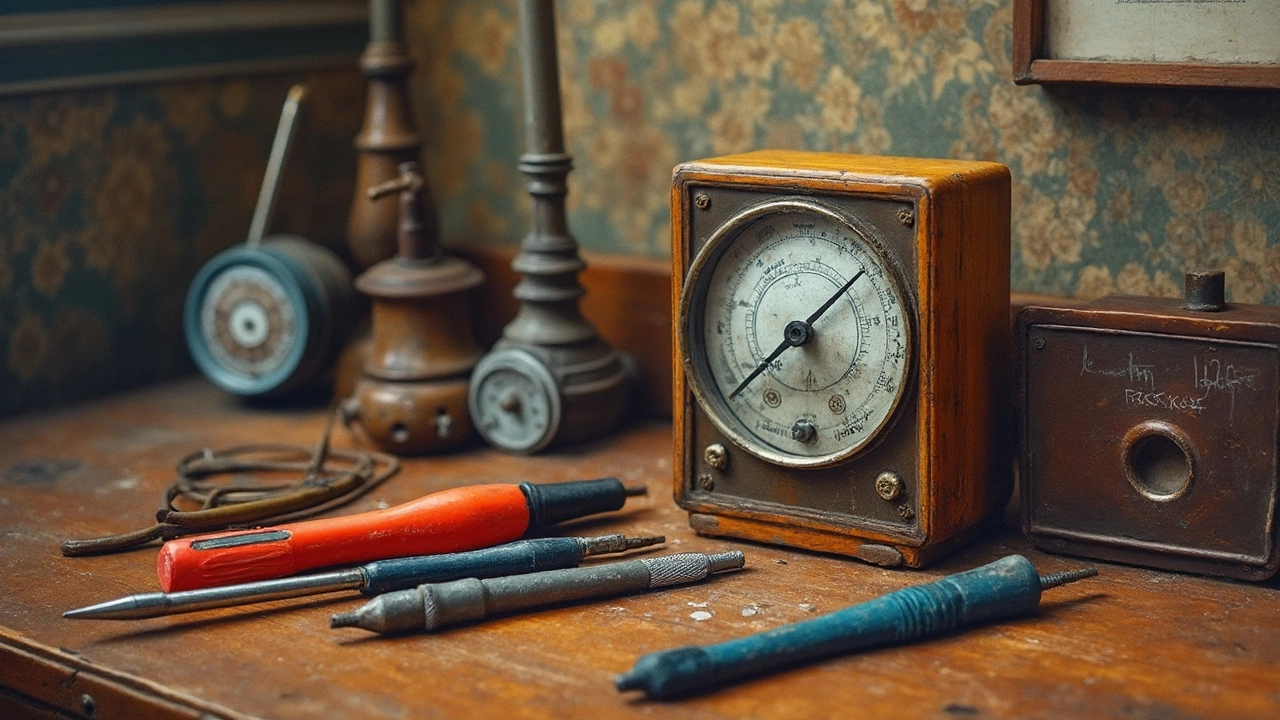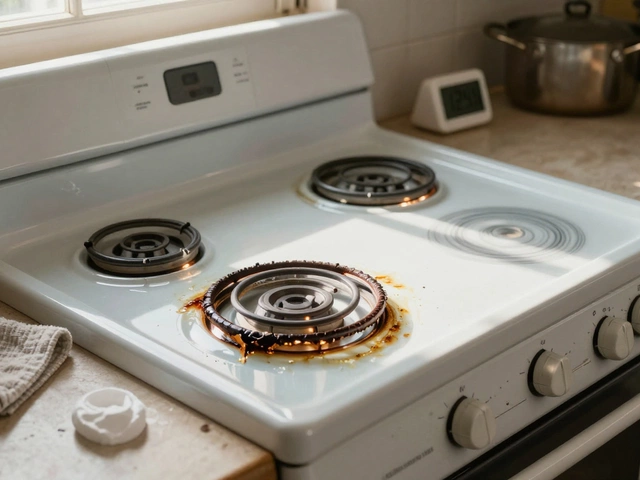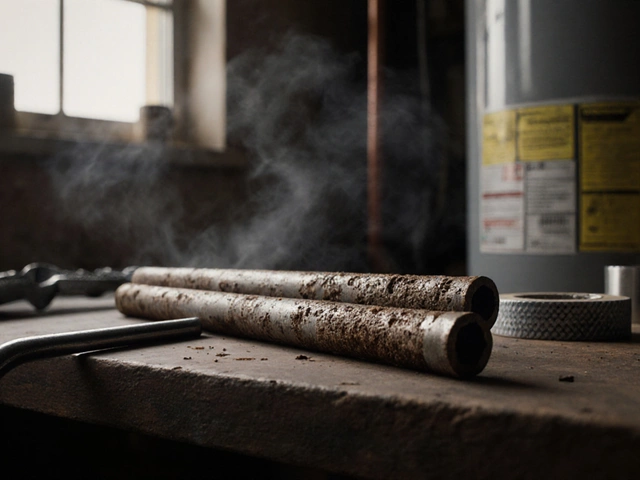Ever had your water heater suddenly give up on you, leaving you with an unwelcome icy shower? Yeah, that's no fun. If your water heater keeps tripping, it's likely an issue lurking in the circuit or thermostat. But don't worry, it's not all doom and gloom. By understanding what might be causing these interruptions, you're one step closer to a functioning heater.
First off, let's consider the circuit breaker. A tripped breaker could simply mean it’s doing its job, but it could also indicate a wiring issue or an overloaded circuit. Before you reset it, take a moment to inspect if something else is pulling too much power on that line. Moving on, the thermostat could be out of whack, heating water past the set temperature, causing the safety mechanism to trip. Remember, component checks inside the tank might not be a DIY job if you're not comfortable with it.
- Understanding Why It Trips
- Inspecting the Circuit Breaker
- Checking the Thermostat
- Identifying Wiring Problems
- Addressing Water Leaks
- When to Call a Professional
Understanding Why It Trips
When you're dealing with a water heater that keeps tripping, it’s crucial to figure out why it's happening. This not only saves you from the inconvenience but also ensures your safety. Essentially, a water heater trips to avoid electrical overload, short circuits, or potentially dangerous overheating.
Most common causes are tied to electrical issues. For instance, if the circuit breaker is frequently tripping, it might be a sign of a tripping water heater that's put under more demand than it can handle. Older homes often have outdated wiring that simply can't keep up with modern appliance demands. So, checking the age and condition of your electrical system is a good idea.
Overheating Elements
Overheating is another major culprit. If the heating elements within the tank get too hot, the safety mechanism kicks in and trips the system. The reason? Usually a faulty thermostat that isn't correctly regulating temperature or possibly mineral buildup.
Thermostat Malfunctions
Speaking of thermostats, faulty ones are a common disruptor. A stuck thermostat may continue to heat the water beyond the set temperature, causing the system to trip as a safety measure. Ensuring your thermostat functions properly is key in preventing these issues.
Wiring Problems
Problems can also arise with the wiring. Loose or damaged wires can lead to erratic operations that might consistently trip the heater. This kind of issue is better left to professionals, as tinkering with wires can be risky without the right expertise.
Addressing these issues swiftly can save you a headache and potentially larger repair bills. To sum it up, understanding the why is your first step in dealing with a fix for a water heater that won't stay on. Once you've pin-pointed the problem, you’re in a better position to tackle it or call in the pros.
Inspecting the Circuit Breaker
First thing's first, if your water heater tripping is becoming a habit, it's time to check out that circuit breaker. Why? Well, a breaker trips when it detects something potentially harmful, like an electrical overload or short circuit. It's basically your home's defense mechanism against electrical disasters.
Steps to Inspect the Circuit Breaker
- Turn Off the Power: Before you start poking around, make sure the power is off. Safety first.
- Locate the Panel: Your home's electrical panel holds the circuit breaker. Often, it's hiding out in the basement, garage, or a utility room.
- Find the Tripped Breaker: Look for the breaker that’s sitting in the middle or the "off" position. It’s usually pretty obvious.
- Reset the Breaker: Turn it fully off, then flip it back to the "on" position. Listen for a click; that signals it's reset. If it trips again immediately, you might have a more serious problem.
Over time, breaker's sensitivity might actually increase due to wear, causing it to trip more frequently. Interesting fact: circuit breakers are typically rated to last around 10,000 operation cycles, but industrial studies show this can vary based on how often they're used.
When to Worry
If the breaker keeps tripping, it could mean your electric panel can't handle the load. Perhaps there are too many devices drawing power at once. Maybe your water heater has an internal problem. Considering the potential risks of electrical fires, it's wise to err on the side of caution.
In any case where you're not sure what's happening, reaching out to a pro is the smart call. Electricians have the tools and know-how to safely diagnose trickier electrical issues you wouldn't want to tackle on your own.
Checking the Thermostat
When dealing with a tripping water heater, the thermostat is always worth a look. It’s like the little brain of your heater, and if it’s set too high, you might be asking a bit too much of your circuit. So, let's roll up our sleeves and get into it.
Step-by-Step Guide
- Power Down: First things first—safety. Go to your breaker box and turn off the power to your water heater. Trust me, you don't want to mess around with live electricity.
- Access the Thermostat: Most water heaters have a panel covering the thermostat. Unscrew and gently remove it. You might need to push aside some insulation to reach the thermostat itself, but don’t worry, that’s normal.
- Check the Temperature Setting: Ideal settings are around 120 degrees Fahrenheit (49 degrees Celsius). Anything higher can overwork the heating element, kick the circuit breaker into action, and leave you with a cold shower.
- Adjust the Setting: If it’s set too high, lower it to the recommended level. Use a flathead screwdriver to make adjustments, and ensure both thermostats (if there are two) are set to the same temperature for even heating.
- Reassemble: Put everything back the way you found it, panel included. Make sure it’s secure, and restore power at the breaker.
If it still trips, it might be time to bring in the professionals, especially if there's the possibility of faulty wiring or a damaged thermostat. Tackling electrical issues on your own without confidence in the job can be risky.

Identifying Wiring Problems
Alright, let's talk about wiring—one of those behind-the-scenes elements that just has to work right for everything else to run smoothly. If your water heater keeps tripping, suspecting a wiring issue isn't far off the mark.
First, check for any visible damage to the wiring. Look out for frayed wires or any signs of burning. If that's the case, it's definitely time to call in an expert because handling live wires without proper knowledge can be dangerous.
Common Wiring Problems
- Loose Connections: Over time, connections can become loose due to vibrations or aging. These can lead to arcing, which may trip the circuit.
- Short Circuits: A staple in wiring issues, short circuits occur when live wires touch, often calling for a straightforward fix but needing professional skills.
- Corroded Connections: Water heaters are often in humid areas, which can lead to corrosion that interrupts the electrical flow and causes tripping.
Testing the Wiring
If you're handy with a multimeter, you might want to test the continuity of the wires yourself. Make sure the power's off before you even think about poking around with a tool. If the continuity test fails, that's a clear sign something's up with the wiring.
| Wiring Issue | Frequency | Expert Needed? |
|---|---|---|
| Loose Connections | Common | Yes |
| Short Circuits | Frequent | Yes |
| Corroded Connections | Less Common | Maybe |
Remember, while you might be able to spot potential issues, fixing them often requires the skills of a professional. Never compromise on safety when dealing with electrical components.
Addressing Water Leaks
Finding a water leak around your heater is pretty much the red flag no one wants to see. This could mean your heater's tank is rusted, or there's a loose connection somewhere. The fix might seem daunting, but let's break it down.
Check for Corrosion
If you see rusty water or a trail of water stains, it’s a sign that corrosion might have gotten the better of your tank. Small leaks could be sealed temporarily, but extensive rusting often means it's time for a replacement. Remember, trying to patch up a damaged tank is a bit like putting a band-aid on a cracked dam—it's not going to last.
Tighten Loose Connections
Before we assume the worst, inspect the connections—especially the inlet and outlet connections. A simple turnover of a wrench might solve the drip. Make sure valves are tightly closed and ensure all the fittings are snug. You’d be surprised how often a loose nut is the culprit behind a water heater tripping.
Look for Valve Issues
Check the temperature and pressure relief valve. If it's leaking, it could improperly release water because it's faulty or feels the need to relieve pressure. Replace it if necessary.
“Most water heater failures are due to internal rust and sediment. Almost 80% of all heater failures result from neglecting leaks,” says the New Zealand Plumbing Association.
Consider Professional Help
If you're not feeling confident or you've identified the source but don't know how to fix it, calling a professional is your best bet. A qualified technician will make sure that everything is tightened and working properly, and if a replacement is needed, they'll get you sorted.
| Issue | Frequency (%) |
|---|---|
| Corrosion | 50% |
| Loose Connections | 30% |
| Faulty Valves | 15% |
| Other Issues | 5% |
Addressing water leaks swiftly can save you from unexpected cold showers and more costly repairs. So, next time you're in the basement, give that heater a little TLC.
When to Call a Professional
Before you dive too deep into DIY territory, let's talk about when it might be time to step back and let the pros handle it. While many folks enjoy rolling up their sleeves, some water heater issues can be risky and require specific skills.
Signs It's Time for Expert Help
If your water heater keeps tripping despite your best efforts, it’s a solid sign to call in a professional. Here are some red flags to watch out for:
- Electrical Issues: If you're constantly dealing with a tripping breaker or noticing flickering lights when the heater is on, it’s probably not just a fluke. Faulty wiring or other electrical issues should be left to someone with electrical expertise to prevent potential hazards.
- Water Leaks: If there’s water pooling around your heater, it might not be just a leak; it could be a sign of a bigger problem, like a damaged tank. Ignoring this can lead to more costly repairs.
- Unusual Noises: Are there loud banging or popping noises coming from the heater? It could indicate sediment build-up or other issues that require a technician's inspection.
- Age of the Heater: If it's over 10 years old and tripping regularly, it might be near the end of its life. A professional can help determine if it’s time for a replacement.
What's the Cost?
A quick call could save you a ton of trouble down the line, not to mention keep the repair costs in check. Generally, getting a pro to diagnose and fix electrical or leak issues will vary based on the problem's complexity but usually hovers around NZD 100-300. Here’s a quick glimpse of average repair costs for common issues:
| Issue | Average Cost (NZD) |
|---|---|
| Thermostat Problems | 100-150 |
| Electrical Repairs | 200-300 |
| Leak Fixing | 150-250 |
Remember, seeking expert advice early can often prevent bigger headaches, and help you avoid those unwanted cold showers!





